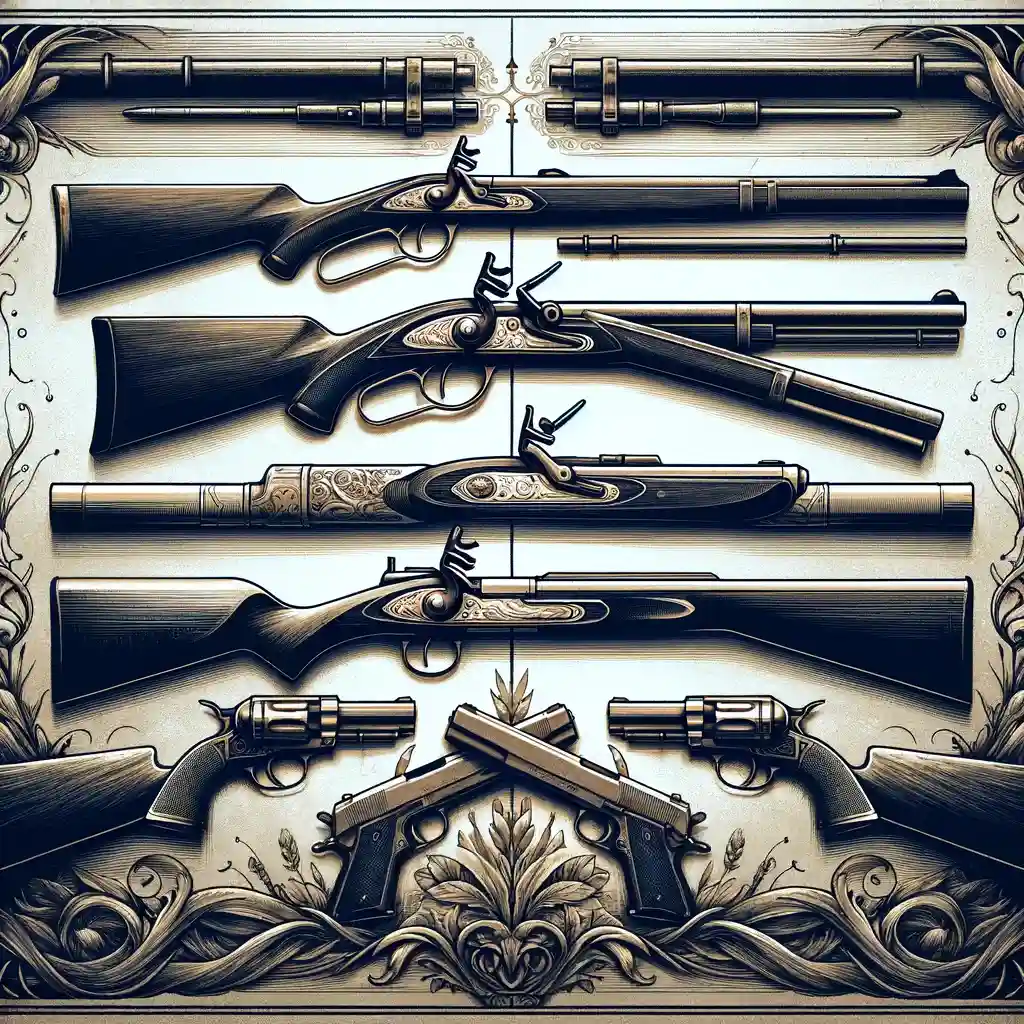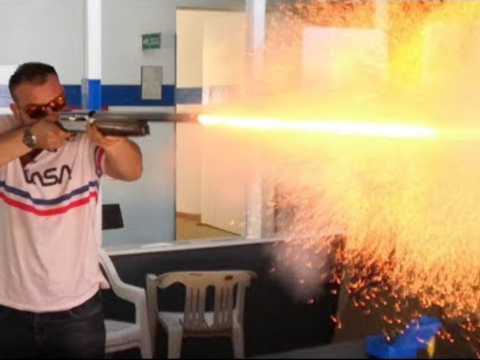Muzzleloaders belong to a class of firearms that stand apart from their counterparts, in significant ways. Unlike the breech-loaded firearms of today, muzzleloaders are loaded from the end, which is why they bear this name. This loading method lends muzzleloaders a charm and historical significance making them popular for purposes.
Introduction
Overview of firearms
Firearms, generally defined, are portable weapons that launch projectiles driven by rapidly expanding high-pressure gas produced by chemical reactions. They have evolved through centuries, from rudimentary handheld cannons to sophisticated modern weaponry, continually shaped by advancements in technology and shifts in tactical requirements.
Introduction to muzzleloaders

Muzzleloaders, a distinctive subset of firearms, have a fascinating history and unique mechanics. As the name suggests, these firearms are loaded from the muzzle—the front end of the gun—using a process that harks back to the days of early gunpowder warfare.
Muzzleloaders have enjoyed a resurgence in popularity among history aficionados and recreational shooters, who appreciate the challenge and historical authenticity they offer, despite the inherent limitations in their rate of fire and practical application in today’s modern warfare context.
Absence of Bore in Muzzleloaders
Explanation of the Lack of a Traditional Bore
Muzzleloaders unlike firearms lack the bore commonly found in the interior of a gun barrel. Instead, muzzleloaders feature a tube design where the projectile and propellant are loaded directly into the muzzle. This design reflects the era when they were utilized as advanced technology had not yet progressed to creating internal barrel structures.
Comparison with Other Firearms that Have a Bore
Compared to muzzleloaders, modern firearms with a bore have an important advantage in terms of accuracy and ease of use. The bore, often featuring rifling—a series of grooves that spin the bullet for better stability in flight—greatly increases the accuracy of the firearm. Moreover, loading modern firearms through the breech is much quicker and safer, allowing for a higher rate of fire.
Historical Significance and Evolution of Muzzleloader Design
The absence of a traditional bore in muzzleloaders is historically significant, pointing to an era when firearms were still in their infancy. The design of these firearms evolved with the technology and knowledge of the time, with early muzzleloaders being straightforward in their construction.
Despite their inherent limitations in design and mechanics, muzzleloaders played a pivotal role in warfare and hunting before the advent of modern firearms, and continue to captivate enthusiasts for their historical authenticity and unique loading process.
Loading through the Muzzle
Detailed Process of Loading a Muzzleloader
Loading a muzzleloader is a unique and intricate process that requires patience and precision. First, the user must pour a measured amount of gunpowder down the muzzle, which serves as the propellant for the projectile.
This is followed by inserting a patch, which helps hold the bullet in place, and then the bullet itself. The bullet and patch are then rammed down the muzzle using a ramrod, ensuring they are firmly seated on top of the gunpowder.
Finally, a percussion cap is placed on the nipple at the rear of the firearm. When the trigger is pulled, the hammer strikes the cap, creating a spark that ignites the gunpowder and propels the bullet out of the muzzle.
Contrasting with the Loading Mechanisms of Modern Firearms
On the other hand, when it comes to firearms they have a different loading mechanism called breech loading. In this method, the ammunition is inserted into the back of the firearm. This approach is known for its speed and efficiency as it allows for the loading of rounds, at once. As a result, it greatly enhances the rate of fire.
Additionally, modern firearms commonly make use of cartridges. Also, modern firearms often utilize metallic cartridges, which house the bullet, gunpowder, and primer in a single unit, simplifying the loading process and reducing the chance of misfires.
Advantages and Disadvantages of Loading through the Muzzle
Despite the slower rate of fire, loading through the muzzle has its advantages. Many shooters enjoy the process, finding it rewarding and meditative. It also offers a direct connection to firearms history, recreating the experience of early gunners.
However, the disadvantages are significant, notably the slower reloading speed and the increased risk of misfires due to improperly seated bullets or moisture contamination. Despite these drawbacks, muzzleloaders continue to hold a special place in the hearts of shooting enthusiasts and historical reenactors.
Muzzleloaders Before the Twentieth Century
Historical Context of Muzzleloaders
Muzzleloaders emerged as a dominant form of firearm from the 15th to 19th centuries, a period marked by global exploration, territorial conflicts, and revolutions. Their development was largely influenced by the desire for more efficient and effective weaponry. The muzzleloader’s ease of manufacture, relative affordability, and decent reliability made them an ideal choice for both military forces and civilians across the globe.
Evolution of Firearms Leading Up to the Twentieth Century
The evolution of firearms leading up to the twentieth century was a gradual process marked by numerous technological advancements and innovations. Initially, firearms such as the matchlock, wheellock, and flintlock were all muzzleloaders. In the mid-19th century, the invention of the percussion cap facilitated more reliable ignition.
The advent of rifling—the technique of making grooves in the barrel—improved the range and accuracy of muzzleloaders. However, the late 19th century saw the emergence of breechloading firearms, initiating a swift decline in the military use of muzzleloaders.
Role and Significance of Muzzleloaders in Various Historical Periods
Muzzleloaders played a pivotal role in various historical periods. They were instrumental in warfare, exploration, hunting, and defense during the Age of Exploration and the colonial era. In the American context, they were prominent during the Revolutionary War and the Civil War, underscoring their importance in shaping the nation’s history.
Despite their replacement by breechloading firearms in the late 19th century, muzzleloaders remained popular for hunting and sport shooting. Today, they are appreciated by history enthusiasts, sportsmen, and reenactors for their historical value and distinctive shooting experience.
Muzzleloaders as Antique Collectibles

Evaluating Muzzleloaders as Antiques
Muzzleloaders, with their historical significance and unique features, are intriguing antiques that captivate collectors worldwide. Evaluating these firearms as antiques requires a comprehensive understanding of their historical context, design specifics, and condition.
Renowned models, such as the flintlock or percussion cap muzzleloaders, can fetch high prices due to their historical importance and rarity. The gun’s condition, including signs of wear, original components, and any visible markings that could indicate its origin or previous owners, also significantly affects its value.
Factors that Make Muzzleloaders Desirable for Collectors
The allure of muzzleloaders for collectors lies in their historical value, craftsmanship, and the sense of nostalgia they invoke. Their role in shaping significant historical events makes them valuable pieces of history.
The craftsmanship that went into creating these firearms, from their intricate mechanisms to their beautiful engravings, speaks volumes about their era’s technological and artistic capabilities.
Moreover, the unique loading process of muzzleloaders offers collectors a tangible link to the past, allowing them to re-live a piece of history.
Comparing the Value of Antique Muzzleloaders to New Ones

When it comes to value, antique muzzleloaders often outshine their modern counterparts. Primarily because of their age, historical significance, and rarity, antique muzzleloaders can be highly sought-after collectibles with price tags to match. In contrast, new muzzleloaders, while impressive in their own right, don’t carry the same historical weight.
However, they can offer a similar shooting experience at a fraction of the cost, making them a popular choice for hobbyists and historical reenactors. Despite this, for serious collectors, the value of owning an authentic piece of history often surpasses the practical benefits of modern reproductions.
Conclusion
The journey of muzzleloaders, from their inception to their gradual replacement by breechloading firearms, is a fascinating tale intertwined with global history. Despite their apparent disadvantages, these firearms laid the groundwork for the modern weaponry we’re familiar with today.
Even in the face of technological advancements, muzzleloaders continue to maintain their relevance, bridging the gap between history and the present. They remain a prized possession for collectors, history enthusiasts, and reenactors, serving as a physical testament to a transformative era in firearms history.
Whether appreciated for their craftsmanship, historical value, or the unique shooting experience they offer, muzzleloaders undeniably hold a distinctive place in the annals of firearms evolution.
Frequently Asked Questions (FAQs)
What is a muzzleloader?
A muzzleloader is a type of firearm that is loaded through the muzzle, the front end of the gun. This is in contrast to modern firearms, which are typically loaded from the rear (breech-loading).
Why did muzzleloaders fall out of military use?
The primary reason is the advent of breech-loading firearms in the late 19th century. These firearms offered quicker reloading times and were generally more reliable, making them the preferred choice for military use.
Are muzzleloaders still used today?
While they are no longer used in military or most law enforcement capacities, muzzleloaders are still popular among hunters, sportsmen, historical reenactors, and firearms collectors.
How do I evaluate the value of a muzzleloader?
The value of a muzzleloader as an antique largely depends on its historical significance, model, condition, and rarity. Factors such as the presence of original components, signs of wear, and any visible markings that could indicate its origin or previous owners can also affect its value.
Is it legal to own a muzzleloader?
In many jurisdictions, it is legal to own a muzzleloader. However, laws vary by location, so it’s important to understand the regulations in your area before purchasing one. Always consult with a knowledgeable source, such as a local law enforcement agency or a lawyer specializing in firearms law.






